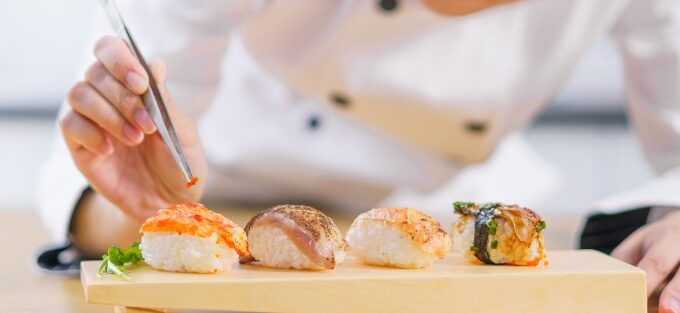The Art of Sushi: A Deceptively Simple Craft
At first glance, sushi may seem like a minimalist dish just rice, raw fish, and a touch of garnish. But if you’ve ever tried making sushi at home or considered enrolling in a sushi making course, you know it’s anything but simple. Sushi is an art form shaped by centuries of Japanese tradition, demanding extreme precision, respect, and consistency. Behind every piece of perfectly rolled nigiri or sashimi lies years of structured training and personal discipline.
In this article, you’ll uncover why Japanese culinary training for sushi is one of the most demanding paths in the food world. You’ll learn how to become a sushi chef, what the training really involves, why discipline is essential, and what mental, physical, and emotional demands come with mastering this timeless craft.
Discipline is the Heart of Japanese Culinary Training
In Japanese culinary culture, discipline is not a suggestion it’s the foundation of everything. As a sushi trainee, you’re expected to follow rules, respect hierarchy, and perfect each skill before moving on to the next.
You won’t start by slicing tuna or crafting signature rolls. Your first months may involve sweeping floors, washing rice, and observing your seniors in silence. These early lessons train your patience and humility qualities that are just as important as technical skill.
Sushi demands excellence. Whether it’s the angle of your knife cut or the pressure of your hands shaping rice, there’s no room for shortcuts. Repeating the same task thousands of times is the only path to precision, and that repetition builds your inner strength as much as your technique.
Inside a Sushi Making Course: What You Actually Learn
Enrolling in a sushi making course is your entry point into this world of discipline. While every school has its own structure, the most reputable programs emphasize the fundamentals, cultural awareness, and hands-on experience under guidance.
You’ll learn the science behind sushi rice how to rinse, cook, season, and store it perfectly. You’ll dive deep into knife skills, learning to cut fish at exact angles that preserve texture and flavor. Hygiene practices are strict and relentless, teaching you how to avoid cross-contamination and preserve the freshness of every ingredient.
But you’ll also learn soft skills: how to stay calm under pressure, how to listen to instructions without complaint, and how to read subtle cues from your mentor. These lessons are just as critical in your journey to becoming a respected sushi chef.
Becoming a Sushi Chef Takes Years, Not Weeks
If you’re wondering how to become a sushi chef, prepare for the long haul. Unlike many other culinary paths, sushi training follows a traditional hierarchy that requires patience and unwavering commitment.
You’ll likely start as a kitchen helper, responsible for cleaning and prepping ingredients. Only after earning your senior’s trust will you be allowed to touch rice, then later, handle fish. The path to becoming an itamae (a head sushi chef) can take up to 10 years or more depending on your dedication and your mentor’s standards.
Throughout this time, you’ll be expected to observe quietly, ask intelligent questions, and accept criticism with humility. The pace is slow, but every moment serves a purpose. It’s not just about learning to make sushi it’s about transforming your mindset and work ethic.
Why Shortcuts Undermine the Sushi Tradition
Modern sushi culture has seen a rise in fast-track courses, YouTube tutorials, and social media influencers showcasing sushi-making hacks. While these methods can offer basic insights, they lack the discipline and depth found in traditional Japanese culinary training.
You can’t rush muscle memory. You can’t fake instinct. And you definitely can’t understand the cultural nuances of sushi from a weekend crash course. Discipline in sushi isn’t just about technique—it’s about mental stillness, respect for the craft, and commitment to quality.
True sushi training isn’t transactional. It’s transformational. It’s not about learning recipes it’s about learning responsibility.
The Mental Toughness You’ll Build
One of the lesser-discussed aspects of sushi training is the psychological endurance it requires. Standing for 12 hours a day, repeating tasks, and receiving blunt feedback can challenge even the most confident individuals. You’ll learn to focus under pressure, handle criticism with grace, and keep striving even when progress feels invisible.
There will be days when your rolls fall apart, your fish cuts are rejected, or your rice is deemed unworthy. These moments teach you resilience. You’ll discover that discipline isn’t just about following rules it’s about showing up, again and again, ready to improve.
Physical Discipline: Precision in Every Movement
Sushi making demands intense physical control. Every motion must be deliberate, consistent, and clean. Your hands need to be firm yet gentle when shaping nigiri. Your knife skills must be razor-sharp both literally and figuratively.
You’ll also need physical stamina. Long hours on your feet, repetitive motions, and constant attention to detail can take a toll on your body. Discipline keeps you sharp, helping you avoid injury and fatigue.
Even the act of sharpening your knives is a ritual that requires patience and care. It’s not just about the tool—it’s about your respect for the craft.
Cleanliness Is a Discipline in Itself
Hygiene isn’t just a rule in sushi kitchens it’s a philosophy. Because sushi involves raw fish and fresh vegetables, the margin for error is slim. A lapse in cleanliness can mean health risks, wasted ingredients, and damage to your reputation.
You’ll be trained to maintain a spotless workstation, sterilize your tools, and monitor storage temperatures with precision. Over time, cleanliness becomes second nature not because someone is watching, but because your discipline demands it.
The Unspoken Rules of Sushi Culture
In traditional sushi kitchens, there’s a silent code of conduct that governs how you act, speak, and move. You must bow to senior chefs, listen before speaking, and never question authority in front of others. These rules aren’t meant to intimidate they exist to create a focused, respectful atmosphere where learning can flourish.
When you serve customers, you’re not just giving them food. You’re giving them an experience shaped by centuries of ritual and etiquette. This is why discipline extends far beyond the plate it touches every interaction, every gesture, and every moment of your service.
Living the Discipline Outside the Kitchen
Sushi training often transforms more than just your career it changes your entire lifestyle. Many sushi chefs carry their kitchen discipline into their personal routines. They become more punctual, more mindful, and more organized in daily life.
Your mindset, your habits, your self-awareness all evolve through the discipline of sushi. It’s a quiet strength that becomes part of who you are, even when you’re away from the cutting board.
Where to Begin: Your Sushi Training Journey
To start your journey, choose a sushi making course that values tradition and practical experience. Look for schools that emphasize mentorship, real kitchen exposure, and Japanese cultural etiquette. If possible, consider traveling to Japan, where you can experience Japanese culinary training in its authentic setting.
Even at home, you can begin building discipline by practicing basic skills—sharpening knives, washing rice, organizing your tools, and repeating techniques with care. Progress may feel slow, but every step prepares you for the next.
Why the Discipline Is Worth It
You may ask yourself if it’s all worth it the long hours, the strict mentors, the endless repetition. But when you finally serve a piece of sushi that reflects your care, skill, and effort, you’ll know the answer.
Sushi training isn’t just about learning to make great food. It’s about mastering yourself. Through discipline, you earn not only the title of sushi chef but the respect, trust, and legacy that come with it.
Final Thoughts
Sushi is often seen as elegant and simple, but the journey to mastering it is anything but. From day one of your sushi making course to your final moments as an itamae, you are constantly tested, shaped, and refined through discipline.
If you truly want to know how to become a sushi chef, understand that it’s a lifestyle, not just a skill. With patience, respect, and relentless practice, you’ll earn your place in one of the most honorable traditions in the culinary world.



